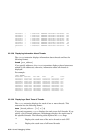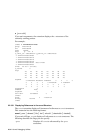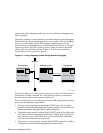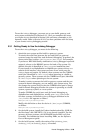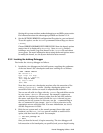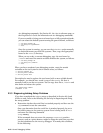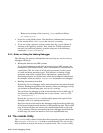To use the kdebug debugger, you must set up your build, gateway, and
test systems as described in Section 2.3.1. Once you complete the setup,
you invoke dbx as described in Section 2.3.2 and enter commands as you
normally would. Refer to Section 2.3.3 if you have problems with the setup
of your remote kdebug debugging session.
2.3.1 Getting Ready to Use the kdebug Debugger
To use the kdebug debugger, you must do the following:
1. Attach the test system and the build (or gateway) system.
To attach the serial line between the test and build (or gateway)
systems, locate the serial line used for kernel debugging. In general, the
correct serial line is either /dev/tty00 or /dev/tty01. For example,
if you have a DEC 3000 family workstation, kdebug debugger input and
output is always to the RS232C port on the back of the system. By
default, this port is identified as /dev/tty00 at installation time.
If your system is an AlphaStation or AlphaServer system with an ace
console serial interface, the system uses one of two serial ports for
kdebug input and output. By default, these systems use the COMM1
serial port (identified as /dev/tty00) when operating as a build or
gateway system. These systems use the COMM2 serial port (identified
as /dev/tty01) when operating as the test system.
To make it easier to connect the build or gateway system and the test
system for kernel debugging, you can modify your system setup. You
can change the system setup so that the COMM2 serial port is always
used for kernel debugging whether the system is operating as a build
system, a gateway system, or a test system.
To make COMM2 the serial port used for kernel debugging on
AlphaStations and AlphaServers, modify your /etc/remote file.
On these systems, the default kdebug debugger definition in the
/etc/remote file appears as follows:
kdebug:dv=/dev/tty00:br#9600:pa=none:
Modify this definition so that the device is /dev/tty01 (COMM2),
as follows:
kdebug:dv=/dev/tty01/br#9600:pa=none:
2. On the build system, install the Product Authorization Key (PAK) for
the Developer’s kit (OSF-DEV), if it is not already installed. For the
gateway and tests systems, the OSF-BASE license PAK is all that
is needed. For information about installing PAKs, see the Software
License Management guide.
3. On the build system, modify the setting of the $kdebug_host,
$kdebug_line,or$kdebug_dbgtty as needed.
Kernel Debugging Utilities 2–39




